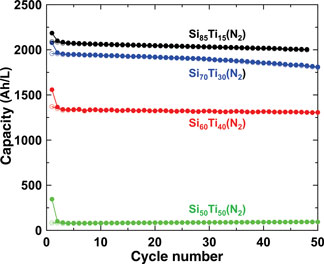Crossref Citations
This article has been cited by the following publications. This list is generated based on data provided by
Crossref.
Ryan, Emily
Pollard, Zoe A.
Ha, Quang-Thinh
Roshandelpoor, Athar
Vakili, Pirooz
and
Goldfarb, Jillian L.
2019.
Designing heterogeneous hierarchical material systems: a holistic approach to structural and materials design.
MRS Communications,
Vol. 9,
Issue. 2,
p.
628.
Cao, Simeng
Bennett, J. Craig
Wang, Yukun
Gracious, Shayne
Zhu, Min
and
Obrovac, M.N.
2019.
Si–TiN alloy Li-ion battery anode materials prepared by reactive N2 gas milling.
Journal of Power Sources,
Vol. 438,
Issue. ,
p.
227003.
Cao, Simeng
Tahmasebi, Mohammad H.
Bennett, J. Craig
and
Obrovac, M.N.
2021.
Si-TiN alloy anode materials prepared by reactive N2 gas milling: thermal stability and electrochemistry in Li-cells.
Electrochimica Acta,
Vol. 396,
Issue. ,
p.
139259.
Feng, Zhi-yuan
Peng, Wen-jie
Wang, Zhi-xing
Guo, Hua-jun
Li, Xin-hai
Yan, Guo-chun
and
Wang, Jie-xi
2021.
Review of silicon-based alloys for lithium-ion battery anodes.
International Journal of Minerals, Metallurgy and Materials,
Vol. 28,
Issue. 10,
p.
1549.
Cao, Simeng
Tahmasebi, Mohammad H.
Gracious, Shayne
Bennett, J. Craig
and
Obrovac, M. N.
2022.
Preparation of Low Surface Area Si-Alloy Anodes for Li-Ion Cells by Ball Milling.
Journal of The Electrochemical Society,
Vol. 169,
Issue. 6,
p.
060540.
Shuangyu, Liu
Mengran, Liu
Ping, Lu
Fulong, Zhang
Juan, Hong
and
Liyan, Wang
2023.
Study on the electrical properties of Cu-based ECMs prepared by TiBN powder instead of W.
International Journal of Refractory Metals and Hard Materials,
Vol. 117,
Issue. ,
p.
106402.
Amna, Riffat
and
Alhassan, Saeed M.
2024.
A Comprehensive Exploration of Polysulfides, From Synthesis Techniques to Diverse Applications and Future Frontiers.
ACS Applied Polymer Materials,
Vol. 6,
Issue. 8,
p.
4350.
